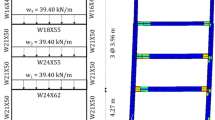Abstract
Seismic force reduction factor (SFRF) spectra of shear-type multi-degree-of-freedom (MDOF) structures are investigated. The modified Clough model, capable of considering the strength-degradation/hardening and stiffness-degradation, is adopted. The SFRF mean spectra using 102 earthquake records on a typical site soil type (type C) are constructed with the period abscissa being divided into three period ranges to maintain the peak features at the two site-specific characteristic periods. Based on a large number of results, it is found that the peak value of SFRF spectra may also exist for MDOF, induced by large high-mode contributions to elastic base shear, besides the mentioned two peak values. The variations of the stiffness ratio λk and the strength ratio λF of the top to bottom story are both considered. It is found that the SFRFs for λF ≤ λk are smaller than those for λF > λk. A SFRF modification factor for MDOF systems is proposed with respect to SDOF. It is found that this factor is significantly affected by the story number and ductility. With a specific λF (= λk0.75), SFRF mean spectra are constructed and simple solutions are presented for MDOF systems. For frames satisfying the strong column/weak beam requirement, an approximate treatment in the MDOF shear-beam model is to assign a post-limit stiffness 15%-35% of the initial stiffness to the hysteretic curve. SFRF spectra for MDOF systems with 0.2 and 0.3 times the post-limit stiffness are remarkably larger than those without post-limit stiffness. Thus, the findings that frames with beam hinges have smaller ductility demand are explained through the large post-limit stiffness.
Similar content being viewed by others
References
Ayoub A and Chenouda M (2009), “Resp onse Spectra of Degrading Structural Systems,” Engineering Structures, 31(7): 1393–1402.
Borzi B and Elnashai AS (2000), “Refined Force Reduction Factors for Seismic Design,” Engineering Structures, 22(10): 1244–1260.
Cai J, Zhou J and Fang XD (2006), “Seismic Ductility Reduction Factors for Multi-Degree-of-Freedom Systems,” Advances in Structural Engineering, 9(5): 591–601.
Chopra AK (1995), Dynamics of Structures: Theory and Applications to Earthquake Engineering, Prentice Hall.
Clough RW and Penzien J (1975), Dynamics of Structures, New York: McGraw-Hill.
Daneshjoo F and Gerami M (2003), “Higher Mode Effects on Seismic Behavior of MDOF Steel Moment Resisting Frames,” Journal of Seismology and Earthquake Engineering, 5(3): 41–54.
GB 50011-2010 (2016), Code for Seismic Design of Buildings. (in Chinese)
Gupta A and Krawinkler H (2000), “Behavior of Ductile SMRFS at Various Seismic Hazard Levels,” Journal of Structural Engineering, 126(1): 98–107.
Humar JL and Rahgozar MA (1996), “Application of Inelastic Response Spectral Derived from Seismic Hazard Spectral Ordinates for Canada,” Canadian Journal of Civil Engineering, 23(5): 1051–1063.
Ibarra LF and Krawinkler HA (2005), “Global Collapse of Frame Structures Under Seismic Excitations,” The John A. Blume Earthquake Engineering Center, Report No.152.
Lee LH, Han SW and Oh YH (1999), “Determination of Ductility Factor Considering Different Hysteretic Models,” Earthquake Engineering and Structural Dynamics, 28(9): 957–977.
Miranda E (1993a), “Evaluation of Site-Dependent Inelastic Seismic Design Spectra,” Journal of Structural Engineering, 119(5): 1319–1338.
Miranda E (1993b), “Site-Dependent Strength- Reduction Factors,” Journal of Structural Engineering, 119: 3503–3519.
Miranda E and Bertero V (1994), “Evaluation of Strength Reduction Factors for Earthquake Resistant Design,” Earthquake Spectra, 10(2): 357–379.
Moghaddam H and Mohannadi RK (2001), “Ductility Reduction Factor of MDOF Shear-Building Structures,” Journal of Earthquake Engineering, 5(3): 425–440.
Nassar AA and Krawinkler H (1991), “Seismic Demands for SDOF and MDOF Systems,” John A. Blume Earthquake Engineering Center, Department of Civil Engineering, Stanford University.
Qu H, Zhang J and Zhao JX (2011), “Strength Reduction Factors for Seismic Analyses of Buildings Exposed to Near-Fault Ground Motions,” Earthquake Engineering and Engineering Vibration, 10(2): 195–209.
Santa-Ana FR (2004), “Estimation of Strength Reduction Factors for Elastoplastic Structures: Reduction Factors,” 13th World Conference on Earthquake Engineering, No.126.
Santa-Ana FR and Miranda E (2000), “Strength Reduction Factors for Multi-Degree-of-Freedom Systems,” 12th World Conference on Earthquake Engineering, No. 1446.
Seneviratna GDPK and Krawinkler H (1997), “Evaluation of Inelastic MDOF Effects for Seismic Design,” The John A. Blume Earthquake Engineering Center, Report No.120.
Tong GS, Ye Y and Zhang L (2013), “Seismic Force with Different Ductility Factor in Strength Degrading System,” Journal of Tongji University, 41(8): 1133–1139, 1157.
Tong GS and Zhao YF (2007), “Seismic Force Reduction Factors for Modified-Clough Hysteretic Model,” Engineering Structures, 29(11): 3053–3070.
Tong GS and Zhao YF (2008), “Inelastic Yielding Strengt h Demand Coefficient Spectra,” Soil Dynamics and Earthquake Engineering, 28: 1004–1013.
Veletsos AS and Vann WP (1971), “Response of Ground- Excited Elastoplastic Systems,” Journal of the Structural Division, 97(4): 1257–1281.
Vidic T and Fajfar P (1994), “Consistent Inelastic Design Spectra: Strength and Displacement,” Earthquake Engineering and Structural Dynamics, 23: 507–521.
Zhai CH, Wen WP, Li S and Xie LL (2015) “The Ductility- Based Strength Reduction Factor for the Mainshock–Aftershock Sequence-Type Ground Mtions,” Bulletin of Earthquake Engineering, 13(10): 2893–2914.
Zhao YF and Tong GS (2009), “An Investigation of Characteristic Periods of Seismic Ground Motion,” Journal of Earthquake Engineering, 13: 540–65.
Acknowledgment
The study is financially supported by the National Key Research and Development Program of China under Grant No. 2016YFC0701201.
Author information
Authors and Affiliations
Corresponding author
Additional information
Supported by: National Key Research and Development Program of China under Grant No. 2016YFC0701201
Rights and permissions
About this article
Cite this article
Li, X., Tong, G. & Zhang, L. Spectra of seismic force reduction factors of MDOF systems normalized by two characteristic periods. Earthq. Eng. Eng. Vib. 19, 53–69 (2020). https://doi.org/10.1007/s11803-020-0547-0
Received:
Accepted:
Published:
Issue Date:
DOI: https://doi.org/10.1007/s11803-020-0547-0




